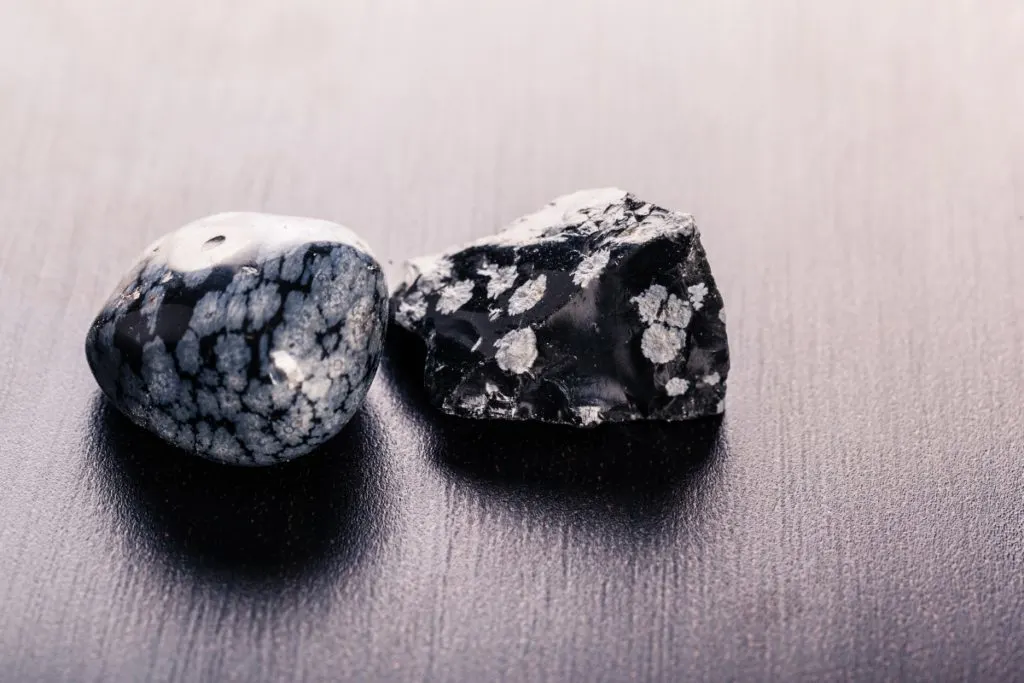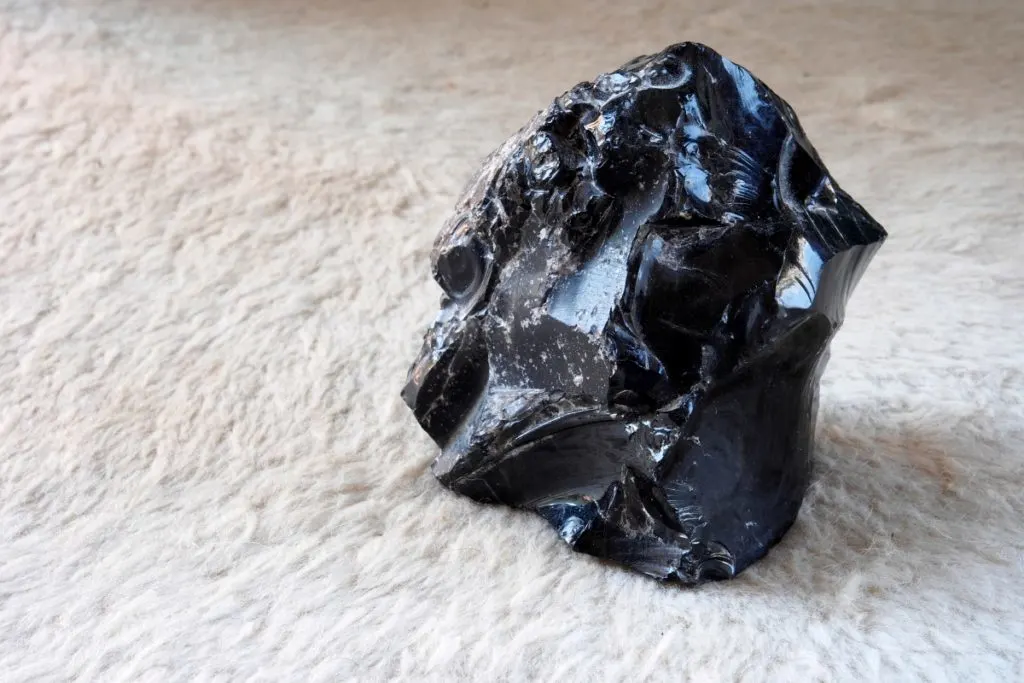As an Amazon Associate, I earn from qualifying purchases with no additional costs for you.
Obsidian is a valuable material with intriguing textures. It is widely used for tumbling, beads, and small sculptures. Even being a widespread opaque and inexpensive stone at first glance, some exceptional rainbow obsidians reach a hundred dollars for a 5 cm polished piece. Mahogany red-and-black obsidians are also extremely popular for jewelry and beads. Some even-colored stones can be faceted and used as calibrated gemstones in jewelry.
Obsidian is valuable for its beautiful textures, rainbow sheen, and snowflake-like appearance. Some stones can have a chatoyancy (cat’s eye) effect. Also, obsidian has been known to humans since ancient times and is very important for archeology. Obsidian was used as knife blades, arrowheads, and mirrors.
Can you imagine that obsidian, we used to think of as black opaque material without any decorative application, can have gentle rainbow colors and a delicate sheen? Rainbow obsidian, cat’s eye obsidian, and Mahogany obsidian can reach hundreds of dollars for a bead necklace. So let’s dispel the myth that obsidian is dull black opaque stone.

If you are interested in checking out the best books about rock and minerals identification you can find them by clicking here (Amazon link).
Is Obsidian Worth Any Money
Ordinary opaque black obsidian is well-known as an inexpensive material? However, other varieties of obsidian are not so popular and widespread, but the price rise for some extraordinary obsidian varieties.
Rough pieces of typical black obsidian usually do not exceed the price of $30 – 50 per kilo. However, snowflakes, Mahogany, and rainbow obsidians are worth more. Additional value for obsidian creates its historical background. Archeological findings made of obsidian usually become museum pieces.
Before shedding light on the value of obsidian varieties, we would like to speak about what obsidian is. You might have noticed that we avoid using terms like mineral and crystal. Obsidian is not a mineral. Scientifically speaking, it’s not clearly a rock, also. So what is it?!
Obsidian is a naturally occurring volcanic glass. It is formed by the rapid cooling of molten lava, and there is not enough time for molten material to crystallize and create a crystal structure. As the obsidian structure is amorphous, it cannot be called a mineral. That is why, scientifically speaking, it is a mineraloid.
Obsidian’s chemical composition is mostly silicon dioxide. Its hardness is 5 – 5.5 on the Mohs scale. Obsidian has a very noticeable feature – a conchoidal fracture. The etalon one.
Also, when chipped, obsidian creates exceptionally sharp edges. This property was highly praised in ancient times, so obsidian was a desirable stone as it was necessary for knives, arrowheads, scrapers, and other tools and weapons production.
Today, archeologists’ findings of obsidian tools usually end up in museums or private collections. That is why the value for these obsidian subjects is far higher than for modern carved pieces.
BTW: Do you want to know more about rock and mineral identification? The books listed below are the best ones you can find on the internet (Amazon links):
- Smithsonian Handbooks: Rocks & Minerals
- Gemstone & Crystal Properties (Quick Study Home)
- Ultimate Explorer Field Guide: Rocks and Minerals (National Geographic Kids)
What is the Value of Obsidian
Obsidian value depends on the quality of the material. Rough common black obsidians cost around $50 per kilo. Beautifully textured obsidians (snowflake black-and-white, Mahogany red-and-black, and rainbow) are worth more. In addition, ancient obsidian knives, arrowheads, and mirrors are precious.
Obsidian occurs in different colors. The most common obsidian is black. Obsidian can also be found in brown, dark-yellow, orange, red, and, occasionally, green, bluish, and purplish. It can be transparent to opaque and sometimes has a sheen. Impurities of various tiny minerals give rise to a variety of obsidian colors.
Let’s figure out the most valuable colors, textures, and varieties of obsidian.
5 Crucial Factors of Obsidian Value
- Texture
The very thirst thing people pay attention to is the color and texture of obsidian.
Obsidian with white or gray cristobalite crystals (a polymorph of quartz that has the same composition, SiO2, but a different structure) contrasting on a black glassy obsidian background resemble snowflakes. This pattern is usually called snowflake obsidian and is widely used as polished cabochon pieces in jewelry.
Mahogany obsidian is an intriguing mixture of brown-red, and black-colored bands swirled together in a single specimen.
This pattern resembles mahogany wood, so this type of obsidian is called so. Red or brown obsidian colors generally result from tiny crystals or inclusions of iron oxides (hematite or limonite).
- Rainbow effect
Rainbow obsidian, together with fire obsidian, is the most valuable material. It was relatively uncommon in the European market but now quickly gained popularity.
According to recent research, rainbow obsidian contains oriented nanorods of hedenbergite, which cause the rainbow effects via thin-film interference (Ma, C. et al., 2001).
Rainbow obsidian main source is the state of Jalisco in Mexico, the La Revoltosa Mine, San Andreas, Municipio de Magdalena. The material from there is usually carved in form of hearts, flowers, and butterflies to maximum display the rainbow effect.
- Fire effect
Fire obsidian, a variety of obsidian from Oregon, has thin layers showing various vibrant colors. A small sample can have vivid pink flashes along with yellow-green parts with orange stripes added on a very contrasting black background.
The layers, 300 to 700 nm thick, consist of concentrated nanocrystals of magnetite, giving rise to brilliant colors in reflection due to thin-film interference (Ma, C. et al., 2007).
- Cat’s eye (chatoyancy) effect
This effect can be observed in sheen obsidian. When cut en cabochon, a light stripe gently moves on a stone’s surface when it’s rotated or viewed from different sides.
Typically obsidian has a golden or silver sheen caused by light reflecting from minute mineral inclusions, tiny rock debris, or gas bubbles formed during the solidification of a lava flow.
- Historical background
Because of the obsidian property to chip and create sharp edges, it was highly praised by ancient people worldwide. Obsidian is a widespread material that can be found near volcanic activity regions.
So obsidian was known on every continent. Obsidian was a valuable and vital resource that the Maya Indians used to make very sharp weapons and tools. All levels of Maya society appear to have had access to and use of obsidian (Nelson, F. W. 1985).
Historical background of obsidian soar prices for some obsidian tools dramatically.
TIP: Mineral identification is an integral part of work for both mineral collectors and scientists. Check out the ultimate step-by-step guide on identifying minerals in the article below:
Easy Step-by-Step Mineral Identification (Expert Explains)
How Much is Obsidian Worth per Pound, Ounce & Gram

The price for obsidian strongly depends on the texture of the stone. Beginning from just $20 per kilo, it can occasionally reach up to $150 for a 5 cm rainbow tumbled stone. Obsidian is usually sold by kilos, rarely per grams or carats. The calculated price per gram rarely exceeds a couple of dollars.
Here is the table of obsidian prices in different units for your convenience.
| Units | Obsidian price |
|---|---|
| per carat | $3 – 5 *for faceted stones |
| per gram | $0.02 – 0.08 |
| per ounce | $0.56 – 2.24 |
| per pound | $9.06 – 36.2 |
| per kilo | $20 – 80 |
Obsidian Value per Color / Type
The most valuable obsidians are stones with snowflakes, Mahogany textures, and rainbow and fire effects.
The price for them can reach $100 for a few centimeters stone. Rainbow and fire samples heat the top. Common black opaque obsidian is usually sold for $20 – 30 per kilo of tumbled stones or big boulder.
| Color of obsidian | Price |
|---|---|
| Green | $6 -10 per 5 x 5cm rough |
| Snowflake | $15 – 20 per 100 gram rough |
| Red | $10 – 30 per 5 -10 cm tumbled stones |
| Raw | $20 – 40 per kilo |
| Black | $20 – 80 per kilo |
| Rainbow | $20 – 150 per 5 x 5 cm tumbled stone |
| Fire | $30 – 170 per small tumbled stone |
| Mahogany | $10 – 40 per 10 grams (50 ct) |
TIP: Acquiring a piece of obsidian that needs to be cut and polished can be quite a stressful task if you have never done it before. Check out the complete guide on cutting and polishing obsidian in the article below:
How to Cut & Polish Obsidian: Follow These 7 Simple Steps
Why is Obsidian So Expensive
Obsidian final price is a combination of factors. The most important one is attractiveness which is represented by textures, colors, optical effects (like rainbow-type and fire iridescence, sheen, chatoyancy), and craftmanship.
Additional value can be created if an obsidian subject is an archeological finding. This type of material will be far more expensive disregarding the attractiveness of stone material.
Some obsidian species are expensive because of fascinating textures resembling snowflakes, Mahogany wood, rainbow, fire, and cat’s eye. The most costly obsidian stones are ancient artifacts like knives, spear points, scrapers, and mirrors. These can be a part of museum collections and hit the top prices.
Conclusion
Obsidian is considered boring dark-colored material with a low potential for decoration and jewelry. However, some varieties of obsidian reach hundreds of dollars per small tumbled stone. Obsidian is used for carvings, beads, and small sculptures.
These are 5 crucial factors of obsidian value:
- Texture. Snowflake and Mahogany obsidians are the most valuable.
- Rainbow effect
- Fire effect
- Cat’s eye (chatoyancy) effect
- Historical background.
Additionally, obsidian is a material known for centuries and with substantial historical background. The price for ancient tools (knives, scrapers, and arrowheads) is discussed at auctions.
The most valuable obsidians are stones with snowflakes, Mahogany textures, and rainbow and fire effects. The price for them can reach $100 for a few centimeters stone. Rainbow and fire samples heat the top. Other common black opaque obsidians can e purchased for $20 – 30 per kilo of tumbled rocks or a big solid boulder.
TIP: Obsidian is the rock that all rockhounds want to have in their collections. But where to find obsidian? Find out the answer in the article below:
Finding Obsidian: 6 Best Locations Near Me (United States)
